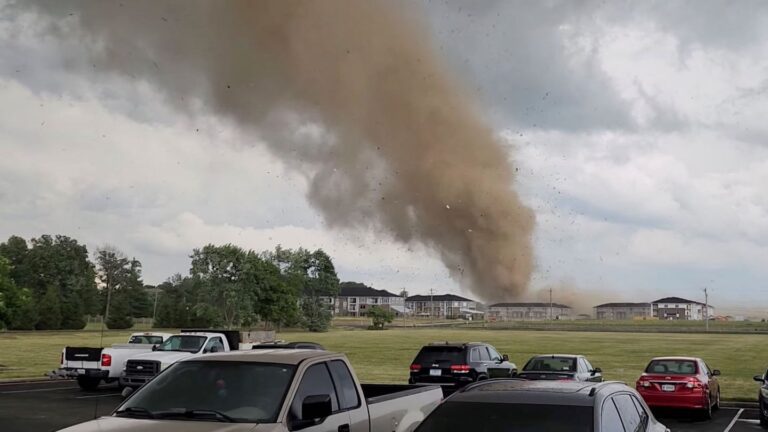There the storms could bring the risk of hail and gusty winds in the afternoon and evening, including golf ball sized hail further south in the Carolina Piedmont. Charlotte and Greensboro, NC, and Columbia, SC, could be affected. there is a level 2 out of 5 slight risk of severe weather there. An individual tornado cannot be ruled out.
The forecast follows a widespread weather episode that brought nearly 450 severe weather reports from Michigan to the Deep South. Baseball-sized hail hit Starke, Martin and Orange counties in Indiana, and softball-sized hail was reported in the state's Owen County. Grapefruit-sized chunks of ice, rare for late June, bombarded the north-central Arkansas town of Thola.
A tornado touched down in Johnson County, Ind., a suburb on the south side of Indianapolis. It swung between Interstates 69 and 65, carving through subdivisions and terrorizing the towns of Waverly, New Whitehead and Greenwood. Seventy-five homes were damaged along the approximately three-mile path of the tornado.
Another tornado was reported further south in Martin County, Ind., midway between Indianapolis and Louisville. At least one person was reported killed after the twister destroyed their home.
There were at least two others reported deaths in Arkansas, where strong winds blew a tree onto a house. There were several other reports of damaging winds with Sunday's storms, including in Jackson, where a gust of up to 76 mph was reported at the airport. An 80 mph gust snapped six utility poles along Highway 64 in Shelby County, Tenn., which includes Memphis, and an equally strong gust of wind toppled a pop-up trailer and snapped trees in Portsmouth, Va.
The risk of severe weather on Monday depends on a pocket of freezing air, low pressure and spin aloft. It is centrally located over the Great Lakes and is within a dip in the jet stream. Warm temperatures will encourage sunny surface air to rise in the afternoon, forming strong thunderstorms. Meanwhile, jet stream winds will provide a boost that storms can mix into the ground in the form of damaging wind gusts.
At ground level, a cold front reached from western Lake Erie to Columbus, Ohio, Nashville and was moving east. This will be the trigger for which storms form. A warm front was moving north toward New York City, causing a warm, sweet, and largely unstable air mass to spread across the Mid-Atlantic. This will provide fuel to trigger strong storms.
MCS debris tracks over the Mid-Atlantic and suppresses the thermal environment. Strong CIN currently applies to most of the ENH risk area.
I expect thermo to recover some, but lapse rates appear lower than forecast and shear is limited. The time will be later #vawx pic.twitter.com/938GaY6cZU
— Peter Forister ⚡️🌪️⚡️ (@forecaster25) June 26, 2023
In central Virginia, a feature called an MCV, or midscale convective vortex, was moving in. This remnant swirl of weak low pressure from Sunday's storms blanketed a blanket of clouds overhead, reducing daytime heating and reducing the risk of severe weather.
That said, thunderstorms are still possible along and west of Interstate 81 by mid-to-late afternoon, pushing east toward Interstate 95 by evening. Initial storms may produce large hail before eventually coalescing into clusters and lines, which would have a greater risk of damaging winds.
They will switch to the Richmond to Washington to Philadelphia corridor during the second half of the evening commute, arriving in Chesapeake at 7 p.m. or 8 p.m. and targeting the Delmarva Peninsula or pushing off the Carolinas by 10 p.m. The weather may delay warming more slowly during the day, meaning it may take a little longer for storms to break out.
Additional storms, some expected to be strong, are possible along the immediate Mid-Atlantic coastline on Tuesday before the cold front moves offshore.

